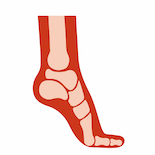Frequently Asked Questions
Flat Foot
Flat feet, also known as pes planus or “fallen arches,” refers to a condition where the arch of the foot is flattened and, in some cases, in contact with the floor. Flat feet do not always cause pain, but a person with flat feet is more likely to experience symptoms such as heel pain, shin splints, bunions, Achilles tendonitis, knee pain, and lower back pain. Other factors that can influence the likelihood of pain are obesity, footwear and activity.
The vast majority of patients find that they can control their symptoms with the use of non-surgical treatments. Footwear is a key factor. The correct size, width, and, depth of the shoe are essential, along with adequate support to hold the foot in position (laced up). You will be advised on the best shoe for your problem.
As there are many causes of ‘flat feet,’ the podiatrist will assess the feet as well as other external factors before deciding on an appropriate treatment plan. This may include exercises, stretches, icing, orthotics, footwear advice and weight loss. A safe diet plan can be made with our qualified dietician.
Leg Length Discrepancy
A leg length discrepancy (LLD), describes a difference in the length of the legs, from the hip bone down to the feet. Having small variations (0.1mm to 0.5mm) in leg length is not uncommon, and may or may not cause any pain or problems. When the LLD is more significant (>0.5mm), it may cause changes in a person’s gait (the way they walk), leading to pain or complications, and impact a person’s quality of life.
Some of the symptoms of LLD include Lower back pain when standing for any length of time (functional scoliosis)
- Hip pain
- Scuffing of one foot or tripping regularly
- Bending one knee when standing to find comfort
- Soreness in the arch or ankle
- Hitching the hip to try to clear the ground
- Shorter steps on the affected leg
- Slower walking speed
- Uneven loading and pressure distribution between the legs
- Stress fractures
- Muscular strain and tendinopathies
- Knee pain
When a leg length discrepancy exists, it can often be observed by the trained eye. We use this information, along with your symptoms and biomechanical data, to identify the extent of the difference and determine if treatment is necessary.
If treatment is required, then it is directed towards alleviating the leg length inequality with an in-shoe raise or a custom-made foot orthotic. Often, this can help offer an immediate correction of gait problems, as well as allow any muscle/tendon overuse injuries to heal.”
Bunion
bunion, also known as ‘hallux valgus’, is a deformity of the big toe in which the big toe angles excessively towards the second toe and leads to a bony lump on the side of the foot. They are often painful in the later stages of development. Early treatment by a podiatrist with custom made orthotics and good footwear will slow down the progression of a bunion. A podiatrist will assess the gait and bio-mechanics of the foot and prescribe an orthotic accordingly.
Bunions form when the normal balances of forces to the foot are disrupted. Abnormalities in walking and bio-mechanical problems such as excessive rolling in of the foot (overpronation), short second metatarsals, ligament laxity and differences in leg length are the main cause of bunions. They develop slowly over the years often beginning unnoticed in childhood. Genetics can also play a part with bunions being seen in several generations of one family.
Common contributing factors include poorly fitted shoes, the wearing of high heels, flat feet and arthritis.


